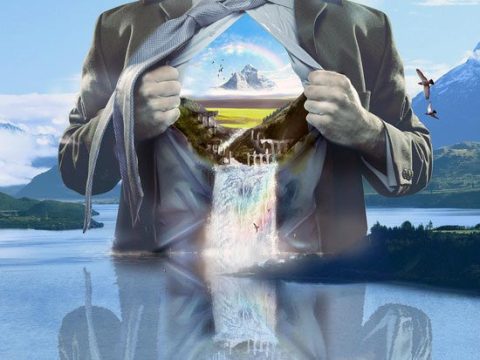Neuroscience & The Next Level Of Consciousness
May 7, 2017 § 8 Comments
 [Javiera Estrada, “Pillars of Creation.”]
[Javiera Estrada, “Pillars of Creation.”]
”When you listen to a thought, you are aware not only of the thought but also of yourself as the witness of the thought. A new dimension of consciousness has come in.”
Neuroscientists at the University of Sussex have identified what they regard as evidence of higher consciousness.
“Consciousness is measured on a sliding scale by the diversity of the brain signals given out and ranges from wakefulness to a deep coma, normally. However, researchers have now found that when under the influence of certain drugs, that diversity range is well overstepped.” (Scientists Uncover A Higher State of Consciousness.)
By measuring magnetic fields in the brain, researchers observed a higher diversity of brain signals when on psychedelic drugs. Users of psychedelics would not be surprised at all.
 [Javiera Estrada, “Pillars of Creation.”]
[Javiera Estrada, “Pillars of Creation.”]
Obvious though it may seem, the importance of this discovery can not be underestimated. This shows us that the spectrum of consciousness has a larger radius of possibility then previously measured.
The typical report of someone on psychedelics mirrors language of the saints & the mystics—a state in which the sacredness of life becomes self-evident. (See Parallax post: “Beyond Division: Studies in Bliss.) This bodes well for the future of humanity, since developing higher states of consciousness has pulled significant & mounting public interest. How else can we save our species from self-destruction but to awaken its higher centers, starting with our own.
Meditation is the most consistent way to access higher consciousness through creating inner space. When we step back from the constant babbling stream of our thoughts, we feel our distinct being-ness outside of the mind’s relentless parade of emotions. According to sacred texts from Vedanta to the Tao, this inner witness is our essential nature, a source of power & peace.

There’s a section of our brains that’s sometimes called the Me Center (it’s technically the medial prefrontal cortex). This is the part that processes information relating to ourselves and our experiences. Normally the neural pathways from the bodily sensation and fear centers of the brain to the Me Center are really strong. When you experience a scary or upsetting sensation, it triggers a strong reaction in your Me Center, making you feel scared and under attack.
When we meditate, we weaken this neural connection. This means that we don’t react as strongly to sensations that might have once lit up our Me Centers. As we weaken this connection, we simultaneously strengthen the connection between what’s known as our Assessment Center (the part of our brains known for reasoning) and our bodily sensation and fear centers. So when we experience scary or upsetting sensations, we can more easily look at them rationally.

I’ve been listening to the Headspace App this month to get me back into a regular meditation routine. It’s first ten sessions are free & I invite you to just try one, because it’s meditation made easy and the benefits for me were immediate. Much easier than trying to dive right in on your own, a helpful guide.

And as Eckhart Tolle reminds us, every action can be a meditation on mindfulness:
“You can practice [witness consciousness] by taking any routine activity that normally is only a means to an end and giving it your fullest attention, so that it becomes an end in itself.”
What are your favorite meditation practices?
Tagged: Consciousness, Inner Space, Inspiration, Meditation, neuroscience, self-development, the witness

This is fascinating. I’ve had experiences in which the sacredness – or aliveness – of all life became abundantly clear to me. And it usually involved deep meditation. Therefore I’m not overly surprised that there are different “levels” of consciousness, although it’s nice to have scientific backing. I also like how you focused on the benefits of meditation. It’s possible to have revelatory experiences without the potential side effects of drugs, which is a good thing.
Thanks so much for your comment, Josh.
You might find this post I wrote a while back on peak experiences of interest! 🙂
https://taicarmen.wordpress.com/category/beyond-division-studies-in-bliss-2/
On on!
TCW
Thanks for the recommendation, Tai. I’ve had experiences similar to the kensho variety you described, although not completely the same. I can never explain them in words, so I’m not even going to try. But in the first and most profound kensho-ish experience, it was as if I could ‘see’ the aliveness of everything around me: trees, rocks, grass, etc. The separarion between us didn’t fall away – but instead I ‘saw’ that we were all conscious, spiritual beings who could relate to each other as equals. It was quite something.
As usual, this research actually says nothing at all that is supportive of religion and yet it is interpreted uncritically as support for all sorts of religious beliefs and practices. As I have previously argued (http://thepsychologist.bps.org.uk/volume-25/edition-7/neuroscience-soul) this twisting of the truth in order to support religion and spirituality is true of much genuinely scientific work on religious experience. Incidentally, mindfulness and meditation also makes narcissism worse – but those findings don’t seem to be reported here…
Thanks for weighing in.
I read your post and the studies you cite could just as easily support my take as yours. As we know, there are no firm conclusions in this field, only questions and some fascinating implications.
As for mindfulness & meditation increasing narcissism, I looked into that and could find no evidence supporting that claim. The goal of meditation is to break down the ego, the source of narcissism. So I think your sense of superior reasoning is misguided.
TCW
Boom: http://www.tandfonline.com/doi/full/10.1080/15298868.2016.1269667
Fantastic blog post, Tai! Thank you.
So glad you enjoyed it, Kate! Thanks for letting me know! 🙂